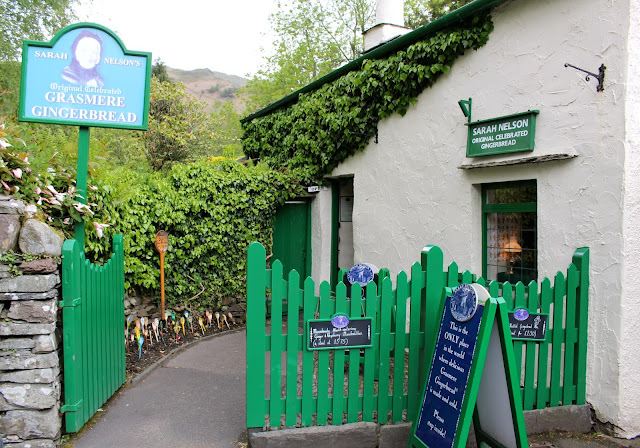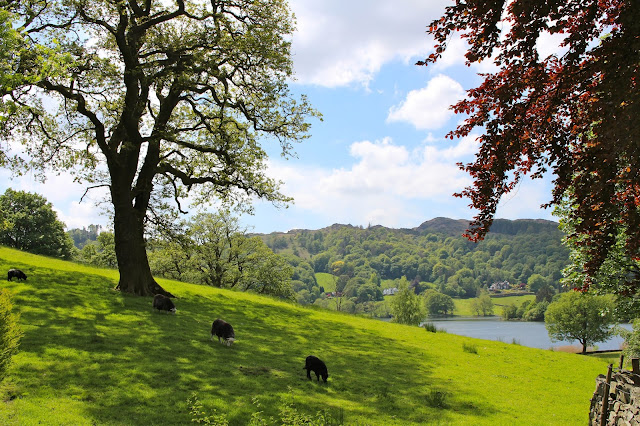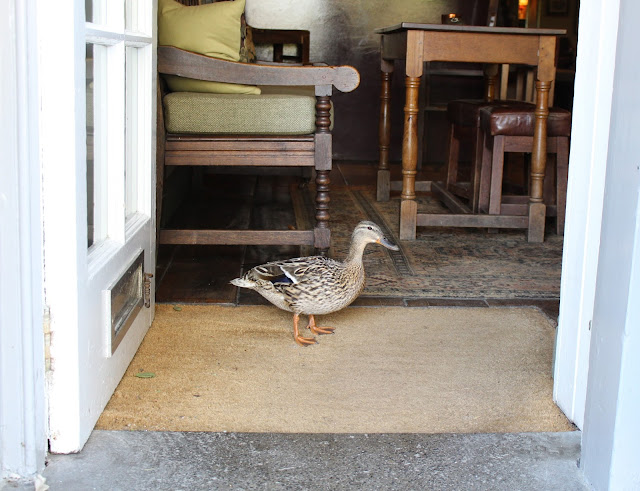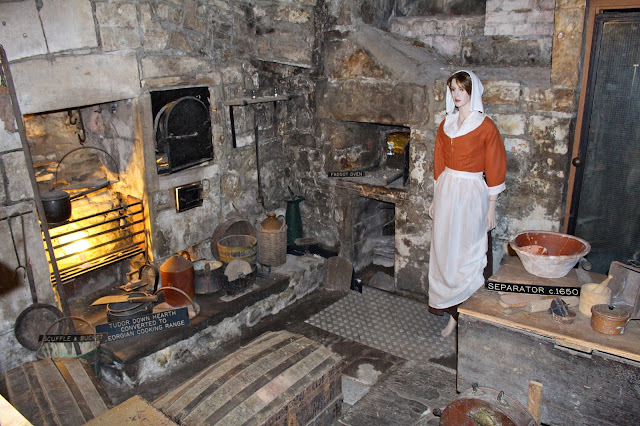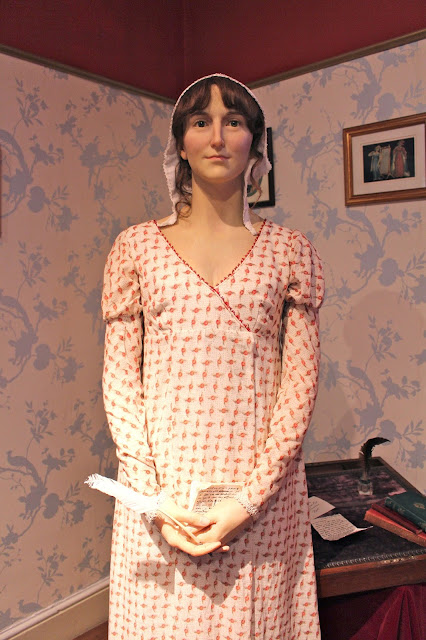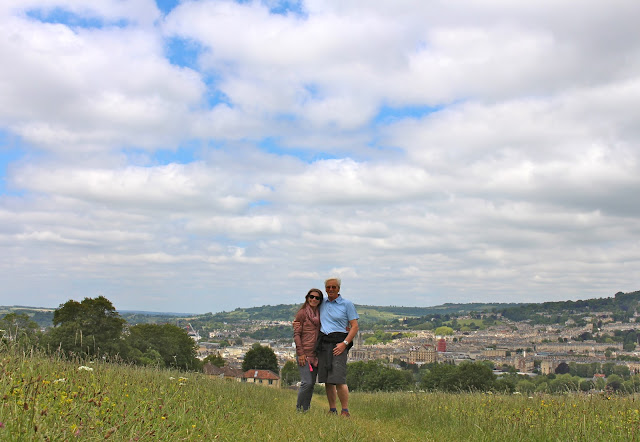there were two little Travelers, and their names were —
Sandi,
and Tim.
And they were in the village of Near Sawrey, two miles south of Hawkshead at the idyllic farmhouse that is a must for Beatrix Potter buffs: it was the first house she lived in after moving to the Lake District, and also where she wrote and illustrated many of her famous tales.

Purchased in 1905 (largely on the proceeds of her first bestseller, The Tale of Peter Rabbit), Hill Top is crammed with decorative details that fans will recognize from the author’s illustrations.
The house features directly in Samuel Whistkers, Tom Kitten and Jemima Puddleduck.
Sandi’s just a little excited about being here.
It’s Mr. McGregor’s garden!
We follow Beatrix Potter’s trail down the lane of her house and out into the village to look for some of the real buildings and features that appear in her tales.
The post box from Peter Rabbit’s Almanac.
The Old Post Office from “The Tale of Pie and the Patty Pan”.
Tower Bank Arms from “The Tale of Jemima Puddleduck”.
And Tom Kitten’s gate from “The Tale of Tom Kitten”. What fun!
The Lake District (or Lakeland, as it’s often known round these parts) is by far and away the UK’s most popular national park. Every year, some 15 million people pitch up to explore the region’s fells and countryside, and it’s not hard to see why.
Ever since the Romantic poets arrived in the 19th century, its postcard panorama of craggy hilltops, mountain tarns and glittering lakes has been stirring the imaginations of visitors.
It’s awash with outdoor opportunities, from lake cruises to mountain walks, but many people visit for the region’s literary connections; William Wordsworth, Beatrix Potter, Arthur Ransome and John Ruskin all found inspiration here.
We’re staying at Holbeck Ghyll Hotel in Windermere.
It’s perched in the hills above the town of Windermere and the views are breathtaking.
We’re in Grasmere primarily in search of its famous former resident, William Wordsworth, but our noses lead us here, to Sarah Nelson’s Gingerbread Shop.
In business since 1854, this famous sweetshop next to the village church makes Grasmere’s essential souvenir: traditional gingerbread with a half-biscuity, half-cakey texture, cooked according to the same top-secret recipe.

On the edge of Grasmere, the tiny, creeper-clad Dove Cottage (formerly a pub called the Dove & Olive Bough) was famously inhabited by William Wordsworth between 1779 and 1808.
The cottage’s cramped rooms are full of artefacts: the poet’s passport, a pair of his spectacles and a portrait of his favourite dog Pepper, given to him by Sir Walter Scott.
Wordsworth lived here happily with his sister Dorothy, wife Mary and three children John, Dora and Thomas until 1808, when the family moved to another nearby house at Allen Bank (Rydal Mount), and the cottage was rented by Thomas de Quincey (author of Confessions of an English Opium Eater).
The chair Wordsworth sat in to write.
Tim reads the news of the day in the early 1800s.
Mary’s cameo.
The back garden of Dove Cottage.
This is the first publication of ‘I Wandered Lonely As a Cloud’. It appeared in a two-volume collection of poems written by Wordsworth while he was living at Dove Cottage, published in 1807. The poem comes from Wordsworth imagination meditating on his walk by Ullswater two years earlier.
This longer version is exactly 200 years old this year and is perhaps the better known poem of the two. It was published in 1815 as part of a review and reorganization of his work published prior to date. Wordsworth took great pains to create the perfect poem. Each republication of the poem offered the opportunity to improve it. His family referred to this as ‘tinkering’ but this description belittles the physical effort involved in revising that would often leave Wordsworth exhausted and unable to sleep.
This small notebook is a great literary treasure—it includes Dorothy Wordsworth’s journal for spring 1802, a journal written she said, “because I shall give William pleasure by it”. Dorothy's account records herself and William seeing the daffodils by Ullswater on a very wet and windy day in April, 1802. “The wind was furious... [it] seized our breath”.
Sandi writes her own version for Tim.
Tickets also include admission to the Wordsworth Museum & Art Gallery next door, which houses one of the nation’s main collections relating to the Romantic movement—including a special exhibition on ‘War & Waterloo’. We’ll let you read for yourself the interesting story in the above photo.
The grand Langdale Chase country house hotel overlooking Windermere Lake.
The dinner menu at Holbeck Ghyll includes canapes, petit fours and coffee. Nothing beats a Kir Royale to kick off a fine meal.
And nothing beats a Three-Chocolate Mousse for dessert. “While here I stand, not only with the sense of present pleasure, but with pleasing thoughts that in this moment there is life and food for future years.” - William Wordsworth, Lines, 1798
Today we’re walking the Grasmere Loop and the Old Coffin Trail.
This popular lakeside trail starts at Dove Cottage along the old pallbearer’s route to Rydal Mount (Wordsworth’s family home from 1813 until the poet’s death in 1850), and makes an easy loop back tracking the shores of Rydal Water and Grasmere Lake.
The gaping maw of Rydal Cave.
“Through primrose tufts, in that green bower, the periwinkle trailed its wreaths; and ’tis my faith that every flower, enjoys the air it breathes.” - William Wordsworth, Lines Written in Early Spring
“Year after year my stock it grew, and from this one, this single ewe, full fifty comely sheep I raised, as sweet a flock as ever grazed!” - William Wordsworth, The Last of the Flock
Heading back into Grasmere.
For top-class dining in the Lakes, nowhere beats The Drunken Duck. It’s become one of the region’s premier foodie destinations, closer to a fine-dining restaurant than a country pub.
Mrs. Drunken Duck greets patrons at the door.
The ales come from the pub’s own Barngates Brewery out back. Cheers!
Bowness-on-Windermere’s best-loved boozer, The Hole in T’Wall pub, is also the town’s oldest, dating back to 1612, with lashings of rough-beamed, low-ceilinged, taxidermied atmosphere.
Abounding with exquisite architecture, oozing history and tradition and renowned for its quirky rituals, Cambridge is a university town extraordinaire. The tightly packed core of ancient colleges, the picturesque ‘Backs’ (college gardens) leading on to the river and the leafy green meadows that surround the city give it a far more tranquil appeal than its historic rival Oxford.
We’re staying at the Hotel du Vin, arguably the country’s swishest, coolest chain. The fun chandelier in the lounge is something we’ve seen before in France.

One of Cambridge’s ancient colleges, Corpus Christi was founded in 1352, a heritage reflected in its exquisite buildings—a monastic atmosphere still radiates from the medieval Old Court.
Back outside, the college’s new Corpus Clock, made from 24-carat gold, displays the time through a series of concentric LED lights. A hideous-looking insect ‘time-eater’ crawls across the top. The clock is only accurate once every five minutes. At other times it slows or stops and then speeds up, which according to its creator, JC Taylor, reflects life’s irregularity.
Trumpington Street.
In a city crammed with show-stopping buildings, this is the scene-stealer. Grandiose, 16th century King’s College Chapel is one of England’s most extraordinary examples of Gothic architecture.

King’s steeples have long been a magnet for student night climbers and today images of the chapel adorn thousands of postcards, tea towels and choral CDs.
Gonville and Caius College boasts three fascinating gates: Virtue, Humility and Honour. They symbolize the progress of the good student, since the third gate (the Porta Honoris, a fabulous domed and sundialed-sided confection) leads to the Senate House and thus graduation.
The picture-postcard snapshots of college life and graceful bridges can be seen from the riverside pathways and pedestrian bridges—or the comfort of a chauffeur-driven punt.
Behind the Cambridge colleges’ grandiose facades and stately courts, a series of gardens and parks line up beside the river. Collectively known as the Backs, the tranquil green spaces and shimmering waters offer unparalleled views of the colleges and are often the most enduring images of Cambridge for visitors.
Most curious of all is the flimsy-looking wooden construction joining the two halves of Queens’s College known as the Mathematical Bridge, first built in 1749. Despite what unscrupulous guides may tell you, it wasn’t the handiwork of Sir Isaac Newton (he died in 1727), originally built without nails, or taken apart by academics who then couldn’t figure how to put it back together.
Cambridge’s intensely atmospheric Round Church is one of only four such structures in England. It was built by the mysterious Knights Templar in 1130 and shelters an unusual circular nave ringed by chunky Norman pillars. The church’s position on Bridge Street reminds you of its original role; that of a chapel for pilgrims crossing the river.
This doesn’t look like much but Sandi’s excited. Many years ago she amassed a large collection of Henry Watson terracotta pottery when it was available for purchase in Vancouver.
We’re now at their factory and shop in Wattisfield, Suffolk. The company was purchased around 1800 by the Watson sons and is now in its 6th generation of unbroken succession. It looks like a sugar bowl and creamer are going home in Sandi’s luggage.
The red fire brick Down Draft Kiln was built in 1940 and used up until 1963 when a major fire destroyed the entire factory. A new factory was built installing electric kilns and the company no longer required a kiln of this nature.
Tim’s brother Richard, his wife Jane, and their son George live in Bishop’s Waltham and we’re here for a visit. Once again, the lovely tradition of a fresh-cut posy greets us in our guest room.
A superb Sunday roast lunch (another oh-so-English tradition) is cooked and served by Jane (a professional caterer) al fresco in their garden. Thank you so much to the Lovells for your gracious and generous hospitality. Lots of love to all!
Britain’s littered with beautiful cities, but precious few compare to Bath. Home to some of the nation’s grandest Georgian architecture—not to mention one of the world’s best-preserved Roman bathhouses—this slinky, sophisticated, snooty city has been a tourist draw for nigh-on 2000 years.
Founded on top of natural hot springs, Bath’s heyday really began during the 18th century, when local entrepreneur Ralph Allen and his team of father-and-son architects, turned this sleepy backwater into the toast of Georgian society, and constructed fabulous landmarks such as the Circus and Royal Crescent.
Bath is justifiably celebrated for its glorious Georgian architecture, and it doesn’t get any grander than on Royal Crescent, a semicircular terrace of majestic town houses.
For a glimpse into the splendour and razzle-dazzle of Georgian life, head for the beautifully-restored house at No 1 Royal Crescent, given to the city by the shipping magnate Bernard Cayzer, and since restored using only 18th century materials. Costumed guides provide historical background (that would be the one on the right).
Looming above the city centre, Bath’s huge abbey church was built between 1499 and 1616, making it the last great medieval church raised in England.
Its most striking feature is the west facade, where angels climb up and down stone ladders, commemorating a dream of the founder, Bishop Oliver King.

In typically ostentatious style, the Romans constructed a complex of bathhouses above Bath’s three natural hot springs, which emerge at a steady 40 degrees celsius (115F). Situated alongside a temple dedicated to the healing goddess Sulis Minerva, the baths now form one of the best-preserved ancient Roman spas in the world, encircled by 18th and 19 century buildings.
The complex of buildings around the baths were built in stages. The famous Pump House was built in neoclassical style, complete with soaring Ionic and Corinthian columns.

The building now houses a restaurant which serves a magnificent afternoon tea.

The building now houses a restaurant which serves a magnificent afternoon tea.
Should you wish you can also sample waters, which were believed in Victorian times to have curative properties.
Eating a bun at Sally Lunn’s is just one of those things you have to do in Bath. It’s all about proper English tea here, brewed in bone-china teapots, with finger sandwiches and dainty cakes served by waitresses in frilly aprons.
The trademark Sally Lunn’s Bun is the house speciality.
In 1680 Sally Lunn, a Huguenot girl refugee from France, found employment with a baker, who had premises in Lilliput Alley very close to the Abbey Church. She introduced the baker to the French brioche type breads, or buns that were later on to become famous and forever associated with her name, the building, and the city of Bath.
The Pulteney Bridge, built in 1773, is one of only a handful in the world to be lined with shops (the most famous example is Florence’s Ponte Vecchio).
Bath is known to many as a location in Jane Austen’s novels, including Persuasion and Northanger Abbey. Though Austen only lived in Bath for five years from 1801 to 1806, she remained a regular visitor, and a keen student of the city’s social scene.
This museum houses memorabilia relating to the writer’s life in Bath, and there’s a Regency tearoom which serves crumpets and cream teas in suitably frilly surroundings.
And there she is! Oops, no, that looks more like Sandi.
Sandi is rawtha sad because she’s missing Mr. Darcy, er, Lovell who, for some strange reason has preferred rawtha to toddle off to the Thermae Bath Spa.
Ah, now here’s the real Jane. Well, real wax, that is. The Centre claims to have drawn on forensic techniques and eye-witness accounts to create the closest-ever likeness of the novelist.
Bath’s seven hilltops offer countryside on the doorstep and the chance to view the city from every angle. The Skyline Walk links quiet woodland, rare wildlife, an Iron Age hill fort and architectural glories.
“I am gone into the fields to take what this sweet hour yields.” - Percy Bysshe Shelley (1792-1822)
Just off the route, 18th century Sham Castle is a folly—a magnificent-looking facade with nothing behind. It looks like a Hollywood film set.
“I really believe I shall always be talking of Bath when I am home again—I do love it so very much.” - Catherine Morland from Jane Austen’s Northanger Abbey, 1755.
Our last stop before heading back to London and home is Lacock Abbey, set in a beautiful setting near Chippenham, surrounded by the water meadows of the River Avon, and a window into a medieval world.


Founded as an Augustinian nunnery in the 13th century, its deeply atmospheric rooms and stunning Gothic entrance are lined with bizarre terracotta figures, like a scapegoat with a lump of sugar on its nose.
Some of the original structure is evident in the cloisters and there are traces of medieval wall paintings too. Elsa, Countess of Salisbury established the abbey in 1232. After the Dissolution it was sold to Sir William Sharington in 1539, who converted the nunnery into a home, demolished the church, built a tower and added a brewery.
A section of the original floor.
The Abbey has been frequently used as the setting for such classic films as Emma, Pride and Prejudice, Robin Hood and the spooky nights at Harry Potter’s Hogwarts School for Wizardry and Witchcraft.
The Sharington family icon was the scorpion, such as this one in a kitchen backsplash tile.
On a hot, summer day in August 1835 William Henry Fox Talbot created the very first photographic negative of this window at Lacock Abbey.
The tiny image, hardly bigger than a postage stamp, is probably the most important artefact in photographic history. It was the result of his ongoing interest, experimenting with light and chemistry to create the correct formula that would fix an image to paper. The ‘latticed window’, as it is known, revolutionized the way in which we see the world. Henry soon discovered that for the first time, a single ‘negative’ could produce numerous ‘positives’ using his process, and hence modern photography was born.
















